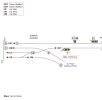Now here's a thought, I may well be shot down in flames!! But it might apply generally to high speed single lead crossovers.
Travelling from Northampton before and after Hanslope was built, I noticed that trains did seem to be more often checked before crossing at Hanslope compared to when they crossed at Roade.
The Roade crossing was slow speed but a double junction. That meant that in, for example when a train crossed Down fast -> Down Northampton the Up fast was only occupied when the train was actually on the diamond. In the case of Hanslope, however, the much longer single leads together with the (not inconsiderable) distance on the Up Fast between the Down Fast -> Up Fast crossing and the subsequent Up Fast -> Down Northampton one meant that, even with the higher speed, occupation of the Up Fast was for a longer time. In addition, if a Down Northampton was brought to a halt for a train on the Up Fast, when moving off the speed would be no higher than at Roade and resulting in a longer delay than before. It seemed to me that the much greater length of a high speed crossover reduces the chance of a path 'across' without being checked, when trains are on a 4 minute headway in the opposite direction. I did measure the time from the first point to the last when crossing over at full speed, but I can't remember what it was - but it was significant compared to the headway.
As I said, I might be wrong in my thoughts!
Interesting that the latest LNw timetable seems to be based around their up and down trains crossing to / from the fast lines simultaneously, though at Ledburn. That seems elegant, but it means all lines are blocked at once for other traffic and does seem to rely on LNw time keeping perfection.

